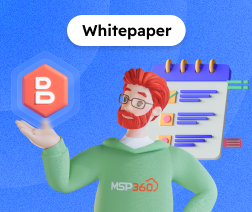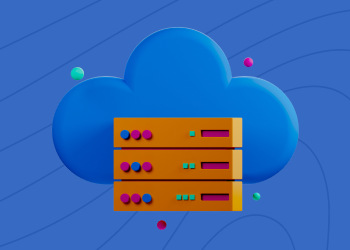A Comprehensive Guide by MSP360 on what is Backup software
Our lives revolve around data and the protection of that data, so in this article, you will learn the critical importance of what is backup software. From irreplaceable photos and documents to crucial business files and applications, information is the backbone of everything we do. But what happens when disaster strikes?
Hardware failures, accidental deletions, ransomware attacks – all these can lead to devastating data loss. This is where backup software steps in, acting as a superhero and your digital lifeline.
What is Backup Software in a nutshell
Backup software is a computer program designed to create copies of your important files and folders or even your entire system. These copies, called backups, are stored in a separate location, ensuring you have a safety net in case the originals are lost or corrupted. Think of it as a digital insurance policy for your irreplaceable information.
What is Backup Software Essentially?
Data loss can occur due to various reasons, some expected and others unforeseen. Here are some common threats:
- Hardware Failure: Hard drives, like any mechanical device, can fail unexpectedly. Backup software ensures you have a copy of your data even if your primary storage device crashes.
- Accidental Deletion: We've all been there – a misplaced click and a critical document vanishes. Backup software allows you to restore these accidentally deleted files.
- Software Corruption: Malware attacks or software glitches can corrupt your data, rendering it unusable. Backups provide a clean, uncorrupted version of your files.
- Natural Disasters: Fires, floods, and other natural disasters can damage your computer and its data. Offsite backups stored in the cloud offer an extra layer of protection.
- Ransomware: A type of malicious software (malware) that blocks access to a computer system or data until a ransom is paid. Typically, the attackers encrypt the victim's files, rendering them inaccessible. To regain access, the victim is demanded to pay a ransom, often in cryptocurrency. Object lock (Immutability) is a data protection feature that prevents objects from being accidentally or maliciously deleted, overwritten, or encrypted. It's like a digital safe that protects your data from tampering. Essentially, it implements a WORM (write-once-read-many) model, ensuring data integrity and compliance with retention policies.
What is Backup Software? Benefits of Use

Investing in backup software offers numerous benefits for both individuals and businesses:
- Peace of Mind: Knowing your data is secure provides peace of mind and allows you to focus on other tasks without worrying about potential loss.
- Disaster Recovery: In the event of a data loss, backups enable a quick and efficient recovery, minimizing downtime and ensuring business continuity.
Further reading Disaster Recovery Planning Best Practices - Improved Security: Backups offer an additional layer of protection against ransomware attacks. By restoring your data from a clean backup, you can avoid paying extortion fees.
- Version Control: Some backup software allows you to maintain multiple versions of your files, enabling you to revert to an earlier version if needed.
- Increased Productivity: Regular backups eliminate the need to spend hours recreating lost data, improving overall productivity.
What is Backup Software: Modes and Types
Different backup modes and types cater to various needs and budgets. Here's a breakdown of the most common ones:
Backup Modes
- Full Backup: This creates a complete copy of your entire system, including the operating system, applications, and data. While comprehensive, full backups can be time-consuming and require significant storage space.
- Incremental Backup: These backups only copy files that have changed since the last backup, saving time and storage space. They're ideal for frequently updated files.
- Differential Backup: These backups take all files that have changed since the last full backup, offering a balance between speed and storage efficiency.
Backup Types
- File and Folder Backup: This allows you to select specific files and folders for backup, providing a more granular approach.
- Image Backup: This creates an image of your entire hard drive, including the operating system, applications, and data. It allows for a complete system restoration in case of a major crash.
- Cloud Service (SaaS) backup: this specific backup type relates to various cloud services, such as Microsoft 365, Google Workspace, etc.
Best practices for backups
Now that you know what backup software is, here are some best practices to ensure your data is truly protected:
- Schedule regular backups: Automate your backups to run at regular intervals, such as daily or weekly, depending on how frequently your data changes.
- Use the 3-2-1 rule: This rule emphasizes creating three copies of your data, storing two backups on independent local media (e.g., external hard drive) and one copy offsite (e.g., cloud storage).
- Test your backups frequently: This best practice allows you to verify that backups are valid when restored.
Further reading Restore Verification - Encrypt backups: Encryption is an important security measure to prevent unauthorized access to backups. Also, it is often required by compliance.
MSP360 Managed Backup offers 128-bit AES and 256-bit AES encryption.
- Set a reasonable retention period for keeping the backup data: Backup retention policies are crucial for data management, security, and compliance. It allows you to control storage costs and meet compliance requirements.


What is Backup Software Conclusion
With an array of options available, selecting the right backup software can feel overwhelming. Here are a few key factors to consider when selecting a backup option:
- Your Backup Requirements: What data do you actually need to back up? Is it your entire system or just specific files or files or folders? How frequently does your data change?
- Backup Destination: Where will you store your backup data? Local storage (external hard drive, NAS) or cloud storage? A combination of both?
- Budget: Free and paid backup software options do exist, but paid versions often offer significantly more advanced features like encryption, object lock, and version control.
- Ease of Use: Consider your technical expertise. Some software options offer a user-friendly interface, while others require more technical knowledge to implement granular backup and recovery plans.
- Scalability: Will your data storage needs grow in the future? Choose backup software and storage that scales to accommodate your expanding data requirements.
Bookmark an introduction to immutable backups, a comparison of Exchange Online vs. Exchange On-Premises, cost-effective backup solutions, what is RMM, why Amazon's EC2 and S3 are fundamentally different types of service, how to resize partitions on Linux, how to retrieve Amazon Access Key ID and AWS Secret Access Key, and an overview of SQL server backup types, before this conclusion!
For more information on MSP360 Backup Software solutions, email us at [email protected]




